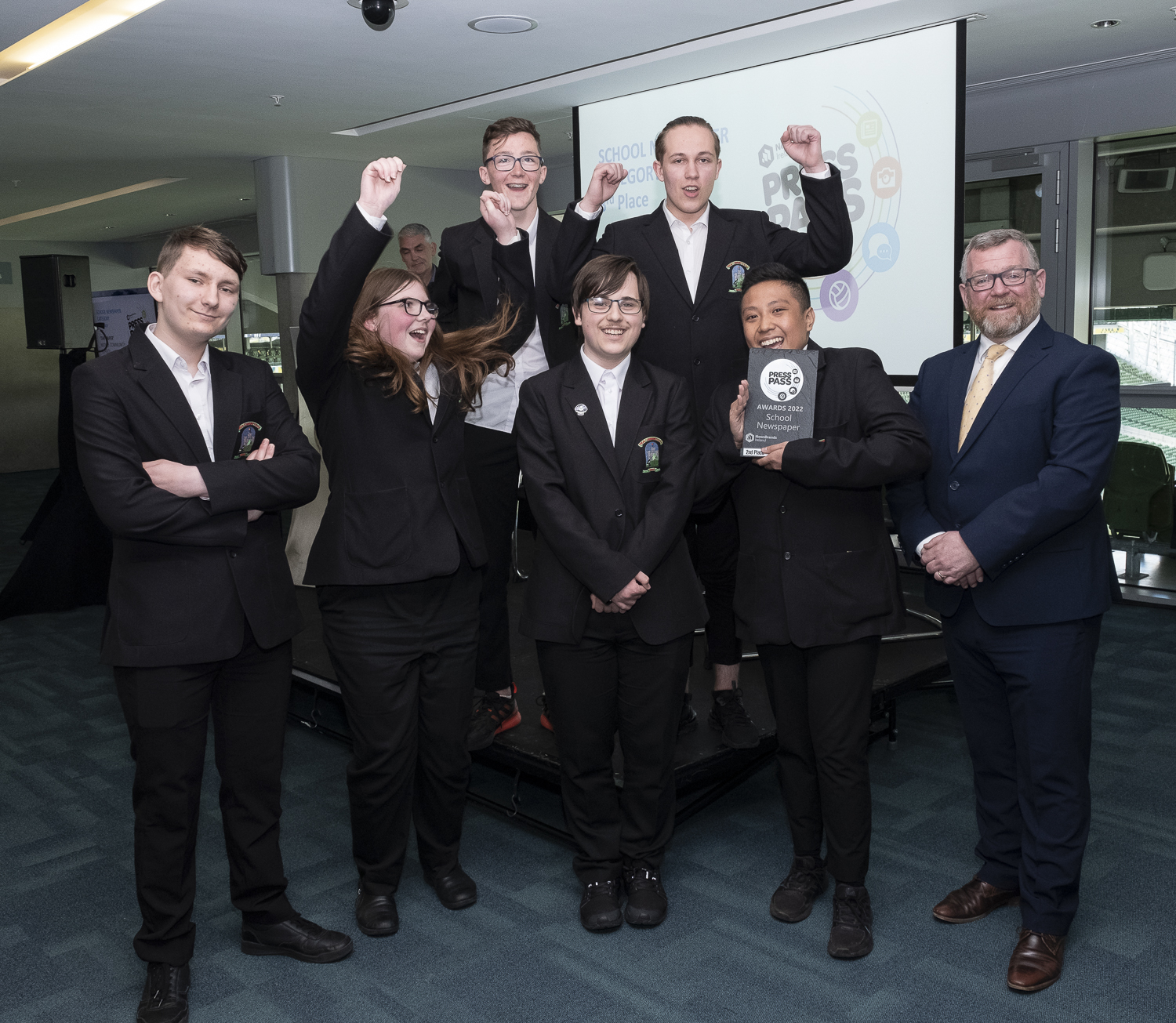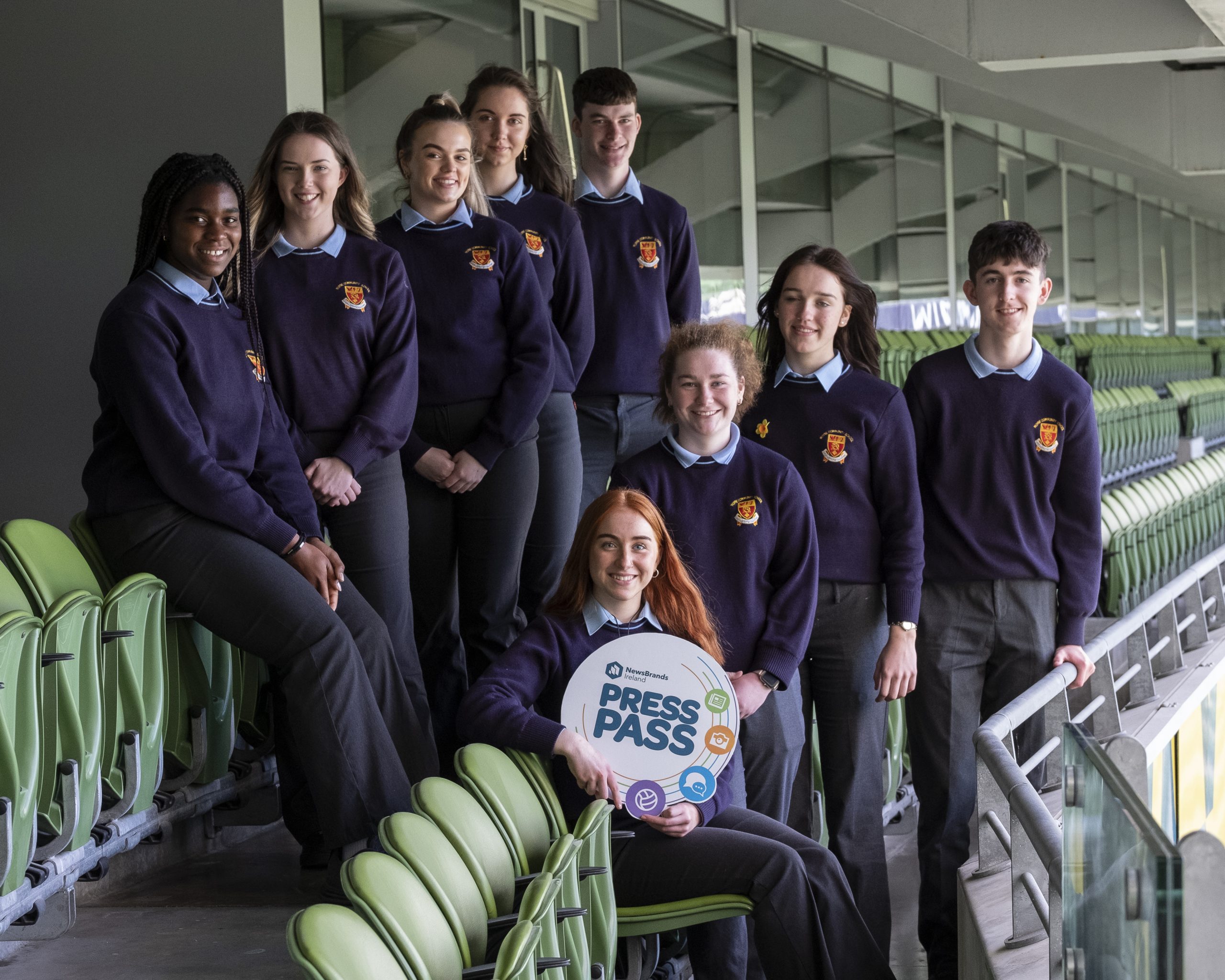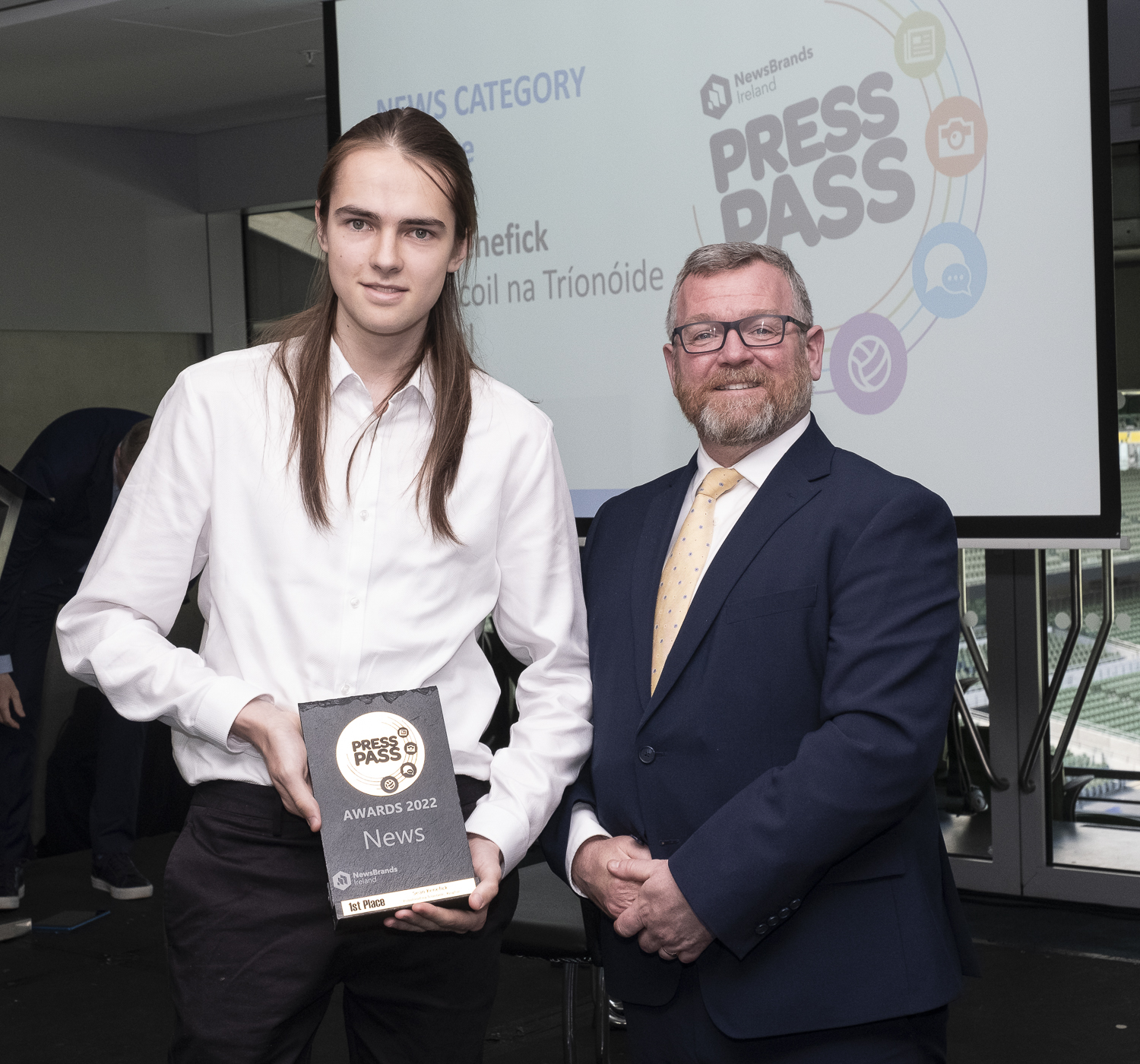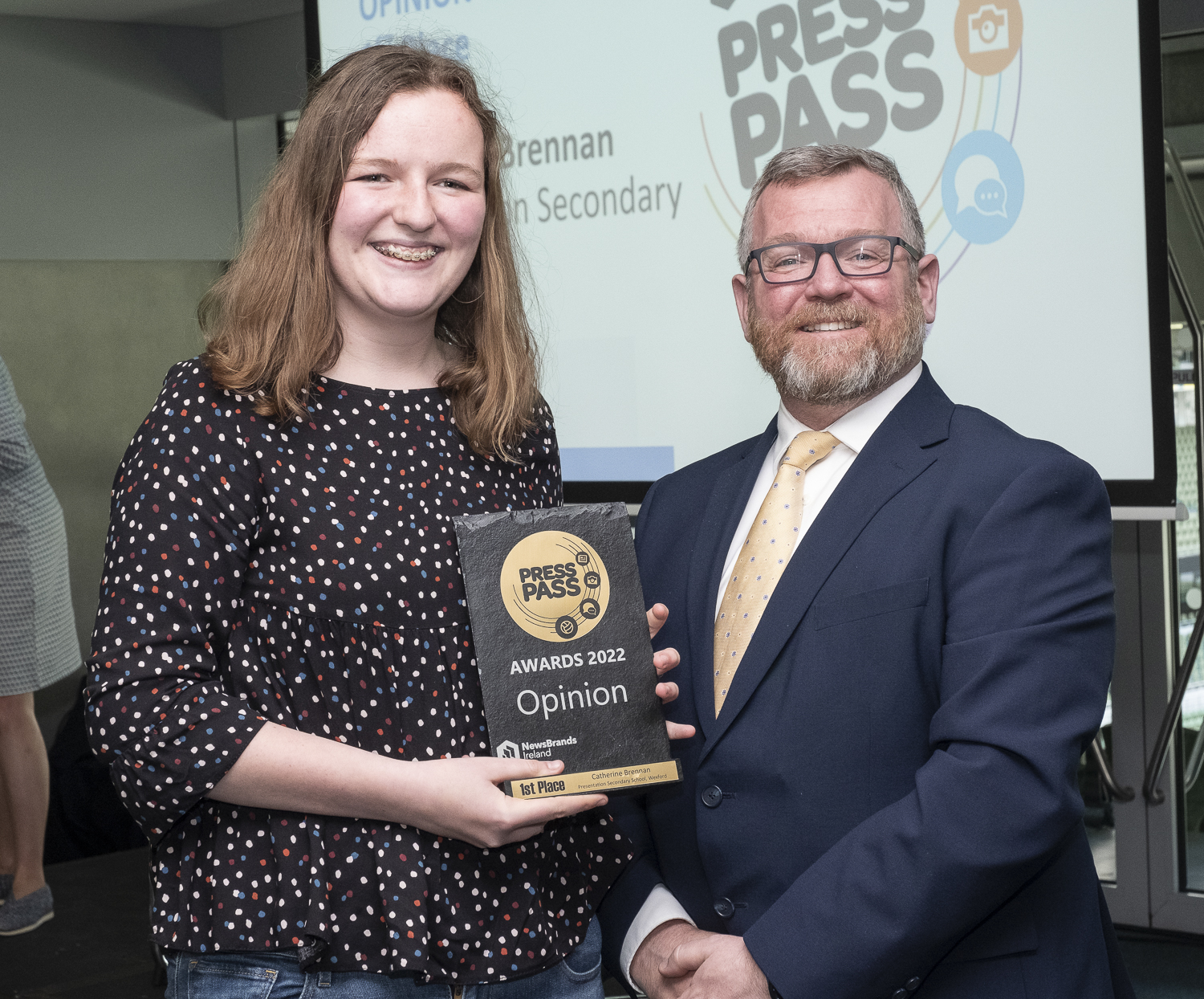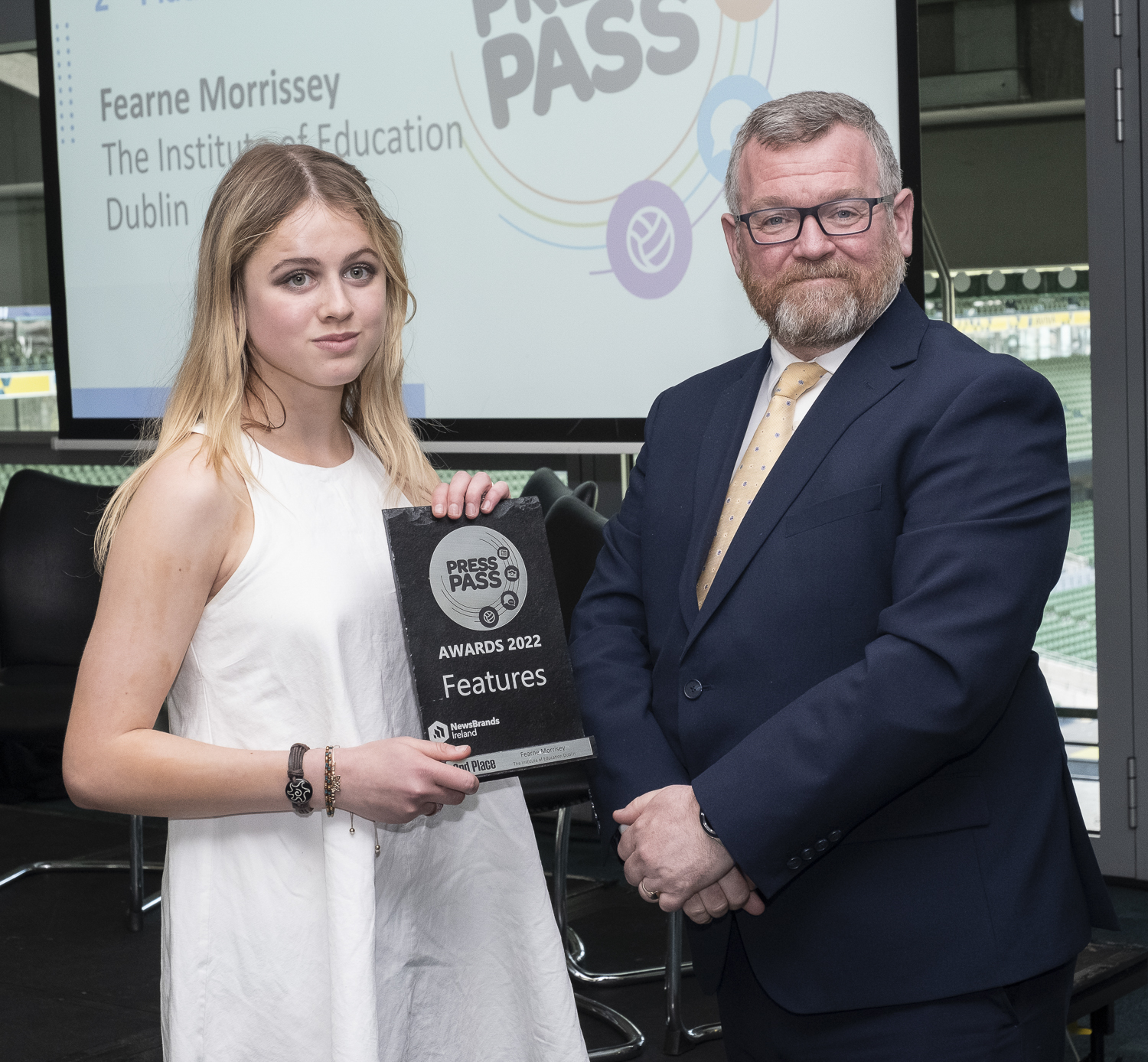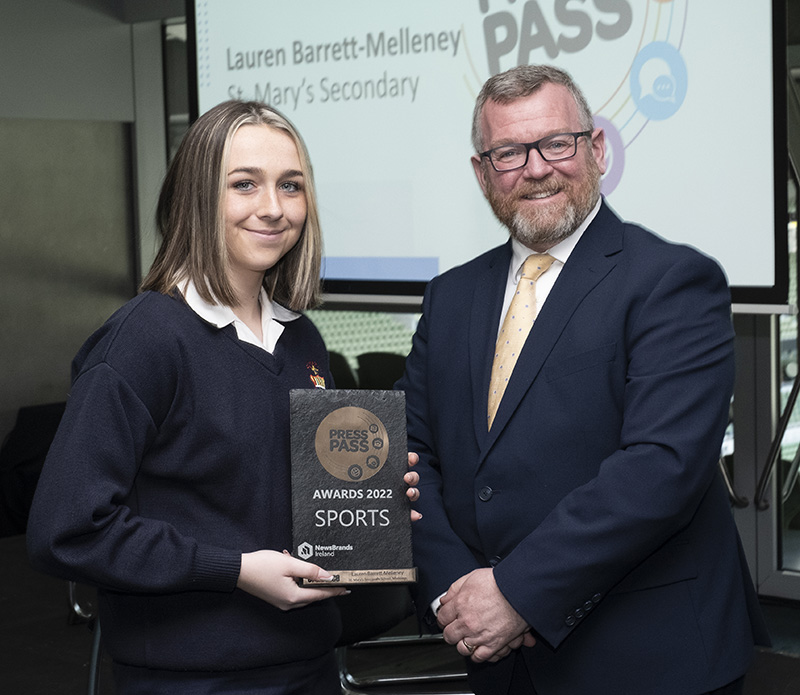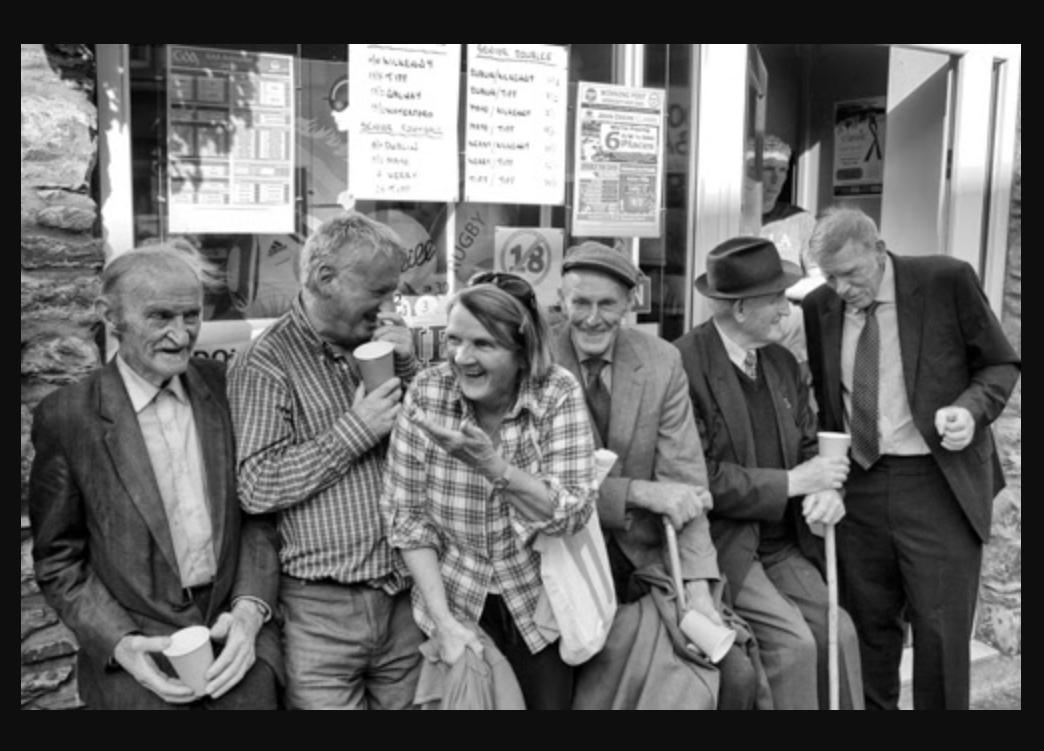
Overall Student Journalist of the Year -
Kate Lynch
- The Institute of Education, Dublin 2
“Heard of breaking the glass ceiling? There isn’t just one. There’s layers of them.”An Interview with the first female Provost of Trinity College: Professor Linda Doyle
Kate Lynch, The Institute of Education, 85 Leeson Street Lower, Dublin
The historic grounds of Trinity College Dublin have been walked by some of the most iconic characters and personalities, from the very real Jonathan Swift, Oscar Wilde and Bram Stoker to Sally Rooney’s brain-children Connell and Marianne and Erika McGann’s hungry cat Pangur Bán. Walking through the wide entrance arch, it’s difficult not to feel some connection with the university’s famed 430 year history. I was on my way to meet ProfessorLinda Doyle. The first woman to hold the position of Provost in Trinity. My mission was to find out what it is like being the trailblazing matriarch of such a significant part of Ireland’s history.
I waited in a comfortable seating room, decorated, to my surprise in a modern fashion, a strange contrast to the medieval building through the window above the plush yellow armchair. An ink print on the wall read“sisters quench thy thirst but not thy rage”and a book on the paintings and memory of Jack B. Yeats rested nonchalantly on the timber hall stand. The office of the Provost herself had the same sense of modernity to it and I was sitting facing Professor Doyle at the sleek, white meeting table.
She spoke fondly of her parents. Her father had to leave school at 16 and her mother even earlier than that. She said education is something her mother always thought was really important. Prof. Doyle described coming home from an open day at UCC and hearing speakers talk about engineering. She thought “that’s really interesting. I want to do that”. I asked her how her parents felt about her entering such a male dominated field and in her own words, “in some kind of maybe naive, but lovely way, they had no preconceived notions”.She described that as empowering. The times being different then, she didn’t even realise the overwhelming majority of males in the subject. She made it clear that she knows not everyone has the same experience as her, saying she hates “people to make statements and expect that to be the experience for everyone” but how she found engineers to be people who just want to solve literal problems, “they’re driving for the solution, and they don’t really care who’s suggesting it”. She told me that Trinity has changed an awful lot in the past decades and despite there being many more opportunities than there were then, it can be quite helpful in all pursuits (even leadership ones) when you just care that the job gets done, not about who is doing it.
In the Professor’s experience running for Provost, in a historic election of three female candidates, she told me “it was very interesting, and people realised it was time for there to be a woman”. She told me that not only were they great candidates but “it both removed women from the equation and put the women in the forefront at the exact same time”. She described this effect as a “parallel” that in the end was “quite useful” as had there been a mixture of male and female candidates, “they would have spent all the time asking the women, you know, what do you think about being a woman versus being a man?”.
We spoke about the symbolism of being a woman in such a position. “I think it’s hugely important symbolically”, she told me, she seemed to rise with a sense of pride as she said “I think it also symbolises a modernity or ‘modern-ness’ about Trinity”. Her powerful conclusion for the impact on other women was “If you can’t see it, you can’t be it”. For her however, it was less about the symbolism, she told me “I just think of myself as a person who has a job to do and wants to do that to the best of their ability.”
As a young woman myself, it was important for me to ask what the Professor’s advice would be, for other women, young and old, who have ambitions and dreams to achieve. Gesticulating passionately, she said “I think women and young women are very, very good at joining dots and big picture stuff and an awful lot of leadership is about that kind of thing”. She looked me right in the eye and told me definitively “don’t be afraid to put your hand up”. This to me, felt like the main message. To all out there who face adversity daily, Professor Doyle, the new “mother of the university” is an example of someone who isn’t afraid to put her hand up. And shatter through layers of glass ceilings.
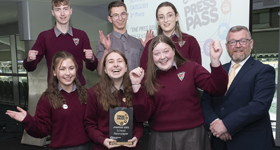
School Newspaper - 1st place
Presentation De La Salle Bagenalstown Secondary School
- Co. Carlow

School Newspaper - 2nd place
Fingal Community College
- Co. Dublin

School Newspaper - 3rd place
Moyne Community School
- Co. Longford

News Category - !st Place
Seán Kenefick
- Pobalscoil na Tríonóide, Youghal, Co. Cork
Blessing of the Boats in Youghal
Centuries old tradition continues in coastal towns
Blessing of the Boats in Youghal in 1953 – credit Mickey Roche
By Sean Kenefick , Pobalscoil na Tríonóide
Uploaded on February 5th 2022
The Blessing of the Boats is an important tradition among Irish coastal towns and villages. For centuries it has been an annual expression of faith by the sea community, taking place every year on the 1st of February, St Brigid’s Day. This year, locals gathered to witness Rev. Canon Thomas Browne P.E. perform a blessing to ensure a safe and bountiful fishing season for the fishermen.
In Youghal, crowds gathered on the quayside with their boats to watch the priests perform the ceremony where prayers and passages are read but this is not a purely
religious event. It is also a time where everyone can come to look and enjoy the sea that’s right on our doorstep. The Mayor of Youghal, Cllr Mary Linehan Foley, and members of the Youghal Boat Club also spoke of upcoming events followed by a water display of boats and jet-skis.
The Blessing of the Boats is a time-honored tradition that dates back many centuries across many different countries. One of the earliest stories comes from Sicily where it is said that a group of fishermen were saved from certain death in a storm. They lost their way in thick fog when they saw a glimmering light in the distance, they followed this light and it brought them back to shore. There they saw that the light from a Madonna del Lume medallion’s reflection is what led them back, since then the “Mother of Light” has been a symbol for fishers’ safety and patroness of fishers in Sicily and some parts of America. It was after this that fishers would start asking people of the clergy to bless their fleets.
Madonna del Lume medallion (Mother of Light)
Local fisherman Mickey spoke of the significance of the blessing: “Though the ceremony is getting smaller in recent years with Covid I think it is still
important to us in the boating community that we carry on the tradition.” It is clear that this small event is still meaningful to the community and a good morale booster to start off the fishing season on a high note:“The fishers have a hard old job that goes unrecognized often, this is a way to give them a little boost of spirit.”
What inspired this article:
Living in a coastal town kind of instilled a love for the sea in my head from birth but the sense of community from this event is what hooked me since it is such an old simple ceremony yet so important to the participants of it, it is a special event you don’t hear of often, it brings the community closer which is something we all need.
See the full article with images:
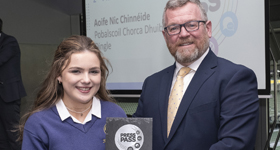
News Category - 2nd Place
Aoife Nic Chinnéide
- Pobalscoil Chorca Dhuibhne, Dingle, Co. Kerry
Pouches Provide Phone Free Zone in Dingle School
Pobalscoil Chorca Dhuibhne a secondary school in the small town of Dingle, Co. Kerry has been making use of a system to limit the use of mobile phones in a school setting. Éamonn Mac Muiris, the principal of PCD, decided to install the Yondr system to control the use of mobile phones in order to ensure the school environment was safer and more sociable.
The special Yondr pouches were introduced in September of 2021 making PCD the first school in Ireland to use them. Each morning before students enter the school building, they must place their phones into the Yondr pouch which is locked shut by a magnetic pin. The phone must be switched off before being placed in the pouch, and cannot be opened without either a teacher’s permission or until the student is leaving the building again. There are magnets located on the outside walls of the school building to open the Yondrs which happens when the pin is tapped against the magnet. The pouches are next to impossible to pull or pry open, as the fastener is a sharp pin that is quite strong and durable ensuring that once the pouch is closed, the phone is inaccessible.
The initial reaction amongst students was predominantly negative with some claiming it was an unnecessary ‘invasion of privacy’ and was ‘far too extreme’. On the other hand the reaction amongst teachers was quite mixed. Some teachers were very pleased with the new approach to phones, as it would ‘help students focus on their schoolwork’ and they hoped the school environment would ‘be more social’. Others argued it was a ‘bit of an overreaction’ and criticised the draconian measures taken to control students’ use of phones.
However, as PCD students have now completed almost a full school year with the Yondr system in place, the initial shock has died down and much of the negativity has gone. Many of the senior students say they can feel the school turning into a more positive social place, and claim their attention is now more fully focused on schoolwork without distraction. Younger students feel the school to be a safer place and agree their attention is more fully focused on schoolwork. One student said “It’s kind of nice not be bothered by the constant pinging every few minutes.” With the acknowledgement that cyberbullying is a massive issue amongst students, the fact that students feel safer without their phones at school is a sign that the Yondrs are increasing students’ sense of security.
Without doubt no matter how effective the system, there are always going to be those looking for loopholes. Students have been caught putting calculators, old phones, phone cases and other items into their Yondr in order to have access to their phones at school. Some students have voiced dissatisfaction with the disparity between those who are obeying the system and those who are not. Regular spot checks are conducted where teachers with mobile magnets require students to open their Yondr and prove their phone is switched off inside it. There is a graduated penalty system for those repeatedly caught without their phones in the Yondr.
Teachers who feared that introducing the system would increase tensions between student and staff have conceded that it has in fact eased the policing of the misuse of mobile phones. One teacher explained how “prior to the Yondr system, while there was a strict no-phone policy, it was quite difficult to enforce as students, like many of us, cannot resist checking the phone during the day. Confronting students about having their phones led to tension. With this system, if the phone is visible, it’s just immediately handed over as it’s not where it’s supposed to be – in the Yondr! It has actually made the no-phone policy enforceable. It has reduced tensions.” Teacher Paula Ní Dubháin said she was happy about the way “students are interacting rather than being glued to a screen”. Teachers are also satisfied with the fact that it is remains easy to use phones as teaching tools in the classroom when required as the pouches can be quickly and easily opened by mobile magnets which are available to teachers.
The experience of PCD to date is that the overall impact of the Yondrs has been positive and of benefit both socially and academically to the school . Principal Éamonn Mac Muiris says, “Young people spend an enormous amount of time staring at screens nowadays, so the idea to limit that during school time is not only great for their focus on schoolwork, but also very beneficial to their health in a broad variety of ways.”

News Category - 3rd Place
Emily Nic Gearailt
- Pobalscoil Chorca Dhuibhne, Dingle, Co. Kerry
Filming Finishes on ‘Tarrac’ Irish Language film pulls to a close in Dingle
Despite facing a number of challenges due to bad weather, filming of the Irish language film “Tarrac”, which loosely translates as ‘pull’, was completed in early November 2021. This contemporary drama set on the Chorca Dhuibhne peninsula in Kerry and in the unique world of Naomhóg boat racing was filmed in and around the town of Dingle in Co. Kerry during the months of September and October.
The focus of the film is a story about a West Kerry woman returning reluctantly to her home town to look after her ill father and making reconnections through naomhóg racing which help her to deal with unresolved issues in her life. Screenwriter, Eugene O’ Brien was inspired by his experiences of the Dingle Regatta which he had attended when on holidays there.
The Many different places in the greater Corca Dhuibhne area are featured in the film. There were various locations used as background settings. The film’s primary locations were piers such as those in Ventry, Dúinín, Dingle and Brandon. A number of beaches were also locations for filming including the panoramic Inch beach and the dramatic strand of Coumeenole.
A considerable number of local people were involved in this project. It created much needed employment late in a summer season which had been heavily impacted by the Covid pandemic. Some local fishermen were hired to assist with safety boats on the days when filming of the Naomhóg races were in action. Dingle Coast and Cliff Rescue assisted on occasions where there were any possible safety concerns. Local taxi drivers also saw brisk business as crew and cast required ferrying to the various locations.
A critical production focus was on getting the right extras for the cast when filming the Naomhóg boat races. In particular it required the recruitment of a cohort of teenage girls who could row the traditional Naomhógs competently. Advertising for these extras took place primarily on social media resulting in a high degree of interest. Twenty local fifteen and sixteen year olds were selected through this recruitment process. One of the local rowers who was chosen, Kila Masset explained how “it was a unique experience. I won’t lie some parts were very tiring and challenging as we were often freezing cold and wet to the skin. But the crew always took care of us with warm blankets and hot drinks. I’m really looking forward to seeing it with all my friends.”
A vital local cog in the entire process was local champion oarswoman Maunza Heidtke of Cumann Rámhaíochta an Daingean (Dingle Rowing Club). Monza played a critical role in preparing actors in their ability to row in the naomhógs and in choreographing the race scenes. She said, “I was very happy when Eugene approached me about the project as I am very proud of the tradition of naomhóg rowing in Dingle. The film captures the excitement and happiness that rowing these brings and especially the binds that form when racing. I can’t wait to see this on the big screen and for the world to see beauty of our boats.”
With a budget of only €1.2 million the director Declan Recks and producer Clíona Ní Bhuachalla had their work cut out for them. Declan has directed some of the top rated shows on Irish Television including the critically acclaimed “Pure Mule” winner of 5 IFTA’s including Best Director; Best Drama IFTA winner “The Running Mate”, and “Scúp” Nominated best Irish Language IFTA.
The film was developed and produced by Clíona Ní Bhuachalla of Icebox films under the cine4 funding programme. The film was also supported by Kerry ETB in particular giving opportunities to those from the Kerry College Monavalley Campus Broadcast Production Skills course.
It was expected that the editing and post production work on the film would be completed in early 2022 after which it is expected that “Tarrach” will be toured on the international film circuit where it is hoped it will draw attention to the unique beauty of Naomhóg racing.

Opinion Category - 1st Place
Catherine Brennan
- Presentation Secondary School, Wexford
What if?
Picture this: A 5ft 10 girl, who always slouches in school photos, and stands next to the tallest person she can see to avoid standing out. Her hair is always tucked behind her ear, although it looks better when it’s just natural. Her nails are always bitten short, despite years of trying to break the habit, and can almost always be found with a furrowed brow and slight scowl on her face. And no, she does not have a posture problem and a miserable personality. It’s because She, well I, have anxiety.
Now in fairness, my life is pretty great. I have two funny and, underneath it all, caring brothers. My dad is a stay-at-home dad, because my mum has such a good job that he doesn’t need to work. I have amazing friends who can brighten up my day, even when I’m having the worst one possible, and at the ripe old age of 16, I have a job that not only earns me money but helps me meet new people and gives me a bit of independence. But that doesn’t mean it can’t also be crap. And I mean miserable, roll up under the covers, I’d-curse-but-this-is-a-school-essay crap. Because of this anxiety.
Because of this anxiety, my days are just a little bit harder. Not always awful, but just harder. For example, I recently had to present an Irish project to my class. It was about my favorite musical, and I really enjoyed making it. However, when it got to presenting it, just the thought of it made my stomach turn. Even as I type this, my palms have started sweating. However, I decided to just put on a brave face and present it. As I stood up in front of my class, my cheeks flushed red, and I started tucking my hair behind my ears. Despite this, I started to speak, and it was all going well. Until, I heard two girls at the back of the class laughing. Now of course, they were probably laughing at a joke one had made, or something that happened earlier that day that was particularly amusing, but to me, it was like a dagger to the heart. Were they laughing at me? Was I doing something wrong? Did they think this musical, one I loved with all my heart, was stupid?
Another example would be playing hockey. Now I don’t want to toot my own horn, but I can be quite good at hockey. I play as a sweeper, so I am the last defence before the goal, and I tell people where to go. However, before every training session, and before every match especially, without fail, I start biting my nails, and my mouth gets drier than the Sahara. I am constantly wondering if my skirt is too short, if people judge me for running too slow, or if people dislike me because I let a goal in.
One final situation would be when I was eleven, and I would shush my class whenever the teacher left the room, and they started to talk. As you can imagine, that did not go down well with a group of tweens who just wanted to chat with their friends. Even I knew they hated it, but that never stopped me. Why? Because of the same reason that made me think those girls were laughing at me, or that anyone cared how fast I ran, or why I would always slouch in photos so I wouldn’t stand out. The constant wondering in my head; “what if?”
What if they did think this show was stupid? What if they were judging me for how fast I ran? What if they thought I was too tall, or they’d get mad when we were talking?
Of course, in my heart of hearts, I knew that no one thought these things. They weren’t laughing at my presentation, no one would judge me for my height, and the teacher wouldn’t explode at us if we were chatting. But that little bit of doubt, those little “what if”’s, is what can lead to me thinking the most horrendous things over the tiniest little detail, and what makes my life a little bit harder.
So yes, my life is pretty great. I have a great family, amazing friends and a good job. But like so many teenagers these days, my life can also be a struggle. Not due to money issues, or fights with friends, but by constantly wondering “what if?”
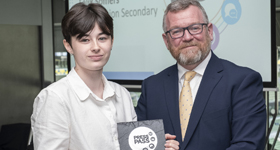
Opinion Category - 2nd Place
Felix Somers
- Presentation Secondary School, Wexford
Why am I like this?
By Felix Somers
I once took my mirror off the wall because I couldn’t look at myself. I saw my face, smiling as I talked to my friend on the phone and the longer I stared at it, the less I recognized myself, as if a stranger were looking back at me. A girl with long brown hair, a high pitch voice and eyeliner. This feeling of… I don’t know what to call it, almost dread washed over me. I clutched my chest, looking down at my body as if I had never seen it before and I cried. I cried for an hour and even after I was finished crying that feeling lingered on.
That mirror was under my bed for a month before I put it back.
Anytime I’m asked to explain why I’m transgender, I can’t do it. I can’t do it because I don’t even know. How can I explain something I don’t fully understand myself? But I know that being trans isn’t just one big thing that you can sum up in a sentence or two. It’s best described by experiences, and that’s what I plan to show you. Here’s a few very short stories that all make me ask why am I like this?
The beginning:
When I was 8, I was standing in school, and I saw a boy next to me. I don’t remember who it was or what prompted this, but I said, “I wish I could be a boy.” My friend looked at me like I had seven heads. I never stopped feeling like that. I honestly don’t know how it took me until I was 15 to accept I was trans. I think it’s probably because when I first heard what it was, it sounded scary. I was 12, I found a few videos on YouTube about people’s coming out experiences. Some good, some bad, some downright terrifying. Then it was transition videos. Top surgery horror stories, testosterone injections, the cost of it all. Then I looked a little more and found statistics. How many people get hate crimed, disowned, end up homeless, depressed. Who would want any of that? The answer is nobody. I didn’t choose to be trans, I chose to live with it.
Just Why?:
One time, my drama teacher implied that I turned my friend trans. Teddy came out to him, and he said, “I think some people in the group might be influencing you to think that.” I was the only other trans person in that group. To be clear, I didn’t influence anything. You can’t make someone trans, that’s not how it works. Yet that’s not the only time I’ve heard that. I’ve been accused of turning people gay, trans, you name it. It’s funny most of the time, because I know people don’t believe it, they just want a scapegoat and I’m more than happy to be that. At least it makes a good story.
My Dad:
The first time my dad gendered me correctly, he called me his nephew… it’s a long story. We were walking home one day, and we were messing around and he tried to tell me I was adopted. Now, anyone that knows me knows that can’t be true because when I was younger, all I used to hear was “ah, you’re the spitting image of your mammy,” which used to drive me crazy, but it basically guarantees I’m not adopted. I pointed that out to my dad, and he thought for a moment before saying “you’re your aunties. We adopted you because she didn’t want you. So technically you’re my… nephew?” I never thought my dad telling me I was adopted would be one of the best things he’s ever said to me, but it was. I got home and texted all my friends, overly excited that he called me a boy and they were all really confused but happy for me.
Kids know things:
A good final story is the time my cousin looked me dead in the eyes and asked his mam “is Kaelyn a boy or a girl?” I sat there shocked as his mam asked why and he just gestured to me, as if to say “I mean, look at him” my auntie told him that people can look however they want, it doesn’t matter if they’re a boy or a girl. A very good lesson but I’m not the case study.
Well, this is the end. I hope you have enjoyed this small section of my life as a 17-year-old trans guy from Wexford town. My story is just one of many, but I felt it was worth sharing. If nothing else, at least I might help someone else keep that mirror up.

Opinion Category - 3rd Place
Nanette McCartney
- Millstreet Community School, Co. Cork
I say “No!” to the N-word
The n-word has been used since the slave era, used to describe black people as they were being stolen from Africa put into slavery, chained, lynched, raped, beaten, spit upon. The word was created as a tool of oppression.
I was only eight years old when I had the talk, this wasn’t like any other kind of talk, like the sex talk, the pregnancy talk or the period talk, you would usually have with a child who has come of age. Instead, this was a talk every black parent and child will have to face in life. When I had the racism talk I knew I’d heard the word before from songs and TV. Just by looking at my mother and thinking back on it, I knew it broke her heart but it had to be done. She told me that many people in this world didn’t like the colour of my skin, the texture of my hair and that they would use this word to put me down, and that no matter where I am I should stand up for myself even though it’s difficult. She said I should be proud of being a black person.
In school I never say the word but instead use the euphemistic phrase the “the N-word” because I was and still am afraid that if I said the word a non-black person will feel free to use it. But l could not escape this two-syllable terror no matter what. I hated reading the book “To Kill a Mockingbird” because whenever the word was quoted in class, I felt like a giant spotlight was shining so bright on me. One day a student said the word and within seconds it poisoned the entire classroom environment and everyone turned to gauge my reaction, but I just sat there and pretended like I didn’t hear anything while bottling up all my emotions. Not so long after another student casually said “the N-word” in front of me and l asked why he felt the need to say that, and he told me that “It’s just a word”.
A word that was created by his ancestors and he could say it whenever he wanted. I told him never to use the word again and that it was used to degrade black people. That’s all l could say because l never really knew what the word means.
All I knew was this is prevalent in the black community and that non-black people would say it to oppress us. For example, when Colin Kaepernick took the knee, or when Barack Obama became president. I never really said anything because it would be seen as being over-principled or as the New York Times said “insufferably woke.” Plus, it is hard talking about the N-word. But why is it really hard talking about it? All l know is that “this six-letter word is like capsule of accumulated hurt” it’s not just about “slavery”. This word is fundamentally an assault on black freedom, black mobility, and black aspiration. Its historical context cannot be erased; maybe that’s why the N-word is hard to talk about.

Features Category - 1st place
Gemma Hannon
- Coláiste Muire, Ennis, Co. Clare
This is a feature article in which I discuss the benefits of equine therapy.
The Power Of Horse
By Gemma Hannon
As I sit in the saddle feeling each furry shoulder reaching forward one by one, listening to the soft clip-clop of each hoof as it hits the surface, I discover the therapeutic and calming side of my favourite sport.
At the mention of therapy, many people think of wooden tables, soft chairs, newly painted white walls, and the smell of freshly brewed coffee. The truth is therapy can take many forms. For some, it may be music, for others spending time with a loved one, but the type of therapy I’m most familiar with is therapeutic horse riding.
Therapeutic riding is an activity that uses the horse as a partner in the therapeutic process. The focus lies on gaining benefits from the unique neuromuscular stimulation whilst riding and handling the horse, and from building a relationship with the horse as part of a therapeutic team. It is proven to be beneficial for several people including people who have cerebral palsy, multiple sclerosis, learning disabilities, autism, Down Syndrome, mental health challenges such as anxiety and depression and acquired brain injury. The warmth and three-dimensional movement of the horse is transmitted through the rider’s body, gradually making it more relaxed and supple, reducing spasms and improving balance, mobility, posture, and promoting better overall health.
I first became familiar with this form of therapy at a young age. When my mother, Karen Hannon set up her business for therapeutic riding on our family farm, we created a multi-sensory experience in a small woodland area including many different surprises like the gushing sound of a running stream or the crunching sound of the rocks as you stepped on them. As a child, the serenity and peculiarities of the place left me in awe. I spent my days venturing through shrubbery and building stick forts with my bare hands. Little did I know I was spending my time in a different type of newly painted white room with the smell of freshly brewed coffee.
As I grew older, I started to notice and observe the people that came to this ‘therapeutic riding’. I became familiar with the children and young adults that came weekly. I didn’t understand how riding the horse every week played an essential role in the lives of the children, but watched and witnessed some of the children slowly improve and strengthen. I have definitely witnessed some miracles. After volunteering to lead the horse for half an hour every Saturday, I got to witness the therapeutic riding process first-hand. It enabled me to learn and understand this process for the first time. My favourite part is noticing small improvements in balance and posture, or the ability to do the activities provided along the way like placing a ball through a plastic pipe.
After talking to Karen Hannon, who is a therapeutic riding instructor at Killulla Stud, I recognised the importance therapeutic riding plays in the life of a child or young adult with disabilities. “You have to recognise that each child is different and adapt to their needs”, Karen explains. “ The riders have to have a lot of trust for the horse and this can take longer to develop for some than others” Not only does therapeutic riding act as psychological therapy for these children with disabilities, but it also acts as a form of physiotherapy. The act of horseback riding rhythmically moves the rider’s body in a manner comparable to a human gait, and recent studies identified small, but meaningful improvements in many areas including motor function, posture, gait, and quality of life. In conclusion, the review found that horseback riding caused significant improvements in every group studied.
I interviewed a couple of Karen’s clients to gain a deeper insight into how horse riding affects their lives. Darragh, aged fourteen who is on the mild autistic spectrum, visits Killulla Stud every Friday. He spends time grooming, petting, and feeding the horses before his lesson. Both Darragh and his parents agree that therapeutic riding benefits him in many ways. “ I love horse riding as it helps me feel relaxed and I love animals,” Darragh says. Another client Sophie engages in therapeutic riding every Wednesday. Sophie has cerebral palsy and is a wheelchair user. She loves animals and looks forward to riding every week. “I love that Sophie does horse riding as it is very good for her core muscle development given that she is a wheelchair user”,states Adrian, Sophie’s mother. It was great to see how important therapeutic riding is to these young adults and their parents.
Discovering therapeutic riding was incredibly interesting to me. It is local to my community and has benefited the lives of many people. Therapeutic riding Services are provided nationwide and I hope they can benefit more people in the future.

Features Category - 2nd Place
Fearne Morrissey
- The Institute of Education Dublin
Preserving the Promenade, a Tidy Towns Tutorial with Donna Cooney
Spring would still happen in Dublin 3 without the help of local Counsellor Donna Cooney, but it would be a decidedly less splendid one. The flowers planted by her Tidy Towns unit proudly bask in the sunlight on one of the first true days of spring, their technicoloured heads cheerfully adorning the Clontarf promenade. Cigarette butts, plastic bags and crisp wrappers are now uncommon on the seaside walkway, dutifully snatched by Donna and her assiduous team of volunteers and placed inside their blue bin bags whenever possible.
I sat down with the council member after an hour of volunteering with the Tidy Towns group she leads. If it wasn’t such a beautiful day, the last sixty minutes could be considered taxing work. I became all too acquainted with the drinking habits of my local community, to the extent that my reeking bag tore from the stress of carrying the collection of beer cans I found stashed in a lane less than a hundred meters from the picturesque promenade.
I’m assured by Donna, over the cup of hot chocolate she graciously bought me, that this Saturday’s haul was not a reflection of the amount of litter we’d usually pick up, as we were cleaning a day after the St Patrick’s Day bank holiday. Overall, Donna is proud to see a general reduction in waste since she started the community’s Tidy Towns group over lockdown.
“We used to have to change our bags after walking maybe 50 to 100 meters because you couldn’t carry your bag with the weight of it. It’s nothing like that now, sometimes we just have a little bit (of waste) at the end of a bag. Generally, I think there has been a reduction and I think it (Tidy Towns) has had the effect of reducing waste.” she beams.
Donna Cooney has played a role in gradually transforming attitudes towards littering, both in her advocacy within the Irish political scene as a member of the Green party, and on a local level in her work with Tidy Towns. As a constituent of Clontarf, I have seen our grassy seafront or “horizontal park” a term Donna used to describe it, actively improve from a dumping ground for boxes of fish and chips, to a community area that residents now treasure.
People actively change their behaviour because of Tidy Towns, she tells me. “I’ve actually physically seen people look at us (the Tidy Towns group) and make sure that they’re hanging on to their litter, making sure it doesn’t blow out of their hands in the wind!” Donna laughs while telling me this. Engaging with the community is clearly a role the councilwoman relishes. Over the time I spent with the volunteers, I witnessed several constituents exchanging respective “hellos!” with Donna as they pass by. Our interview was even interrupted by a man stopping to compliment her hat, a blue cap decorated with a yellow flower, a nod to the colours of the Ukrainian flag.
This sense of wider community belonging is a feature of Tidy Towns Donna finds rewarding. She tells me that “it’s about making friendships, it’s about different generations and different ages. There’re not many things that are so intergenerational that have people interested in their local community and their local environment. That knowledge exchange that you get from talking to different people from different ages with different experiences, it’s all very positive.”
A view held by a portion of society is that tidying up the area should be the task of Dublin City Council alone and that by paying taxes all social responsibilities are fulfilled. Donna Cooney looks to challenge that perspective. Being a local councillor, she sees the budget and knows that despite litter and waste management being the biggest expense, the council is unable to clean the entirety of Dublin City. “We can’t keep putting all our resources into that (litter and waste management) because that leaves less money for other things…. they (constituents) might want the lamppost painted or the pavements fixed.” Donna feels to ease the burden on the council, citizens should actively play a role in litter reduction within the community.
With summer just around the corner, people will flock to outdoor areas such as the Clontarf promenade in increased numbers. Enjoying a meal or a drink in the sunshine is an essential and positive way to spend time with friends and family but an overall increase in foot traffic in natural areas will inevitably lead to more litter. After my conversation with Donna, I would ask everyone to consider getting involved with your local Tidy Towns to preserve the beauty of your area for everyone to enjoy.
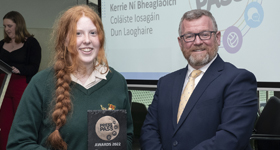
Features Category - 3rd Place
Kerrie Ní Bheaglaoich
- Coláiste Iosagáin, Dun Laoghaire, Co. Dublin
There Is A Lot We Can Learn From Our Elders
How values can be communicated to us with and without words and why this wisdom is worth remembering.
By Kerrie Ní Bheaglaoich
My Grandfather was the wisest man I’ve ever known. He possessed an encyclopaedic knowledge on many subjects – History, Music, Poetry. He didn’t just know things, more than that, he appreciated them. My Grandfather communicated to me that culture in all its forms – Literature, Music and the Arts – are all worthy of preserving, of passing on to a new generation. He didn’t need to tell me, I just knew because he surrounded himself, and by extension, me, with that culture.
His home was a reflection of his interests. I can still remember clearly it’s unique scent. The aroma stemmed largely from tightly packed bookshelves at every wall, filled with varied literature clad in leather bound sleeves. The dusty record player sang, Opera usually being the genre of choice but sometimes Jazz or Blues, depending on my Grandfather’s mood. Paintings and photos, colourful or in stark black and white, looked down on me from his walls.
His taste was eclectic. Objects littered the oak windowsills, memories of the wondrous places he had seen and been. Some were clearly of monetary value, others, smooth stones or pieces of aged wood, simply held value for him. His ‘Study’, piled high with research documents, demonstrated to me from an early age that there was always more you can learn. There was much to be learned in his home, often without any words being spoken.
My early childhood was filled with stories of my Grandfather’s life in inner Cork City. One such tale was a picture he painted in my mind of his own Grandmother, fiercely protective of him. She, wrapped in her black woollen shawl, would drag him, pushing her way to the front of the line for their local cinema. They would pay in bottlecaps, a detail absurd to my young mind. At the time, this story was nothing more to me than an amusing tale, but now I can see there was a lesson to be learned. A lesson about family, about looking after those you love. His Grandmother, an extended family member, was welcomed into his home, protected. In return she protected him. She opened his eyes to a new world, one completely outside of his own. She was poor, but open-minded and unafraid. Without her, I wonder whether my Grandfather would have expanded his horizons, been self-educated, travelled. Would his world have been a much narrower one? Would mine?
Another such story of family sacrifice was the story of his father’s coat. His father, a bus conductor, would every year receive a new winter coat from the bus company. This coat would quickly be stripped from him and altered by his wife to fit my Grandfather, leaving my Great Grandfather in his threadbare, ragged overcoat for the cold spring. I again found this humorous, but as I grew I realised that he had imparted to me the importance of being both resourceful and self-sacrificing for the good of others, the importance of looking after family.
These are just a few examples of the values which were deeply rooted in me from an early age. The knowledge and culture that he valued, I now value. His stories carried a wisdom, an insight that I could never have fully understood without them. A sense of the times that came before us. When our elders are gone, and that insight gone, these stories are what keep both the people and the teachings alive. We must document these stories, while there is still time. We must appreciate these lessons and honour them so that when we are the elders, we may instil them in those who follow us.

Sports Category - 1st place
Sophie O’Reilly
- St Aloysius College
Swim. Bike. Run. Repeat
2024 olympic hopeful Erin McConnell gives an insight into the world of triathlon.
France, 1934. San Diego, 1974. The Skerries, Ireland, 1983. Sydney, Australia, 2000. One might ask; what connects these places, these divisions of time?. The answer is thousands of athletes, one event and three sports. Triathlon – the ultimate trial of endurance. Since its debut in 1974, the event has certainly left an indelible mark on the sporting world, leaving a legacy of historical contests, athletes and human achievements. The roots of Triathlon can be traced back to twentieth-century France, where competitors canoed, biked and ran in an event hailed for ‘the sportsman of the time’. The year 1974 marks its modern debut. The event consisting of three sports – swimming, cycling and running, is backed by Jack Johnstone, Don Shanahan and the San Diego track club. Two participants of this original race – Judy and John collins would go on to Develop the Ironman, the much-publicised iteration of the sport.
Triathlon has remained well and alive in Ireland since the 80s, when Maurice Mullins, a local endurance runner, organised an event in Skerries, Dublin. The Irish Triathlon Association was established in 1984, after which subsequently followed several local affiliate groups who organised races and events. Today, Triathlon Ireland fosters the development of elite and upcoming athletes, one of whom is Erin McConnell.
The sun was just beginning to set when I sat down at the computer and logged onto zoom. Erin was immediately apologetic, despite being perfectly punctual, ‘Sorry about this, I’ve just come in from a run, there was a sandstorm outside!’. Outside her hotel room, a vast Saharan dust cloud engulfs the Spanish skyline with swirling clouds of sand. While the rest of the locality was sheltered inside from the storm, McConnell, accompanied by fellow athletes, braved the elements beneath the red sky.
We begin by briefly discussing the origin of her sporting career. ‘I was always a sporty child, I was involved in everything at school’ McConnell’s dimples emerge as she recalls an active childhood with great enthusiasm. She describes swimming as her first love, a sport that has been in her life since the age of four. In addition, she also competed in Irish dancing, participating in the 40th World Irish Dancing Championships in Glasgow, 2010.
A member of an ETP talent squad in her mid-teens, McConnell was a successful swimmer. However, she recounts her passion for the sport decreasing as she grew older, ‘I found myself chasing times’, or in other words, continually pushing herself in the discipline but not seeing desired results. Erin craved something new and exciting, which is exactly where Triathlon came into play.
The sport was introduced to her in a rather unorthodox way. McConnell was late for a swimming gala; ‘someone saw me running across the car park of the NAC [national aquatic centre] ‘It all started from there.’ ‘I think it [triathlon] appealed because It was something I didn’t know a lot about Attending her first training camp in Dublin at the age of 15, McConnell progressed quickly in Triathlon. Some of her greatest achievements as a junior athlete include; 3rd at the junior European cup in Bucharest, 2nd in the Irish sprint national championships, first in the 2019 Sprint Triathlon National Championships and Junior triathlete of the year.
When asked as to which discipline she preferred, McConnell hesitates. ‘I don’t really have a favourite discipline, you have to like them all really’. Certainly, an advantage of Triathlon is the variety of sports and training activities an athlete can participate in. McConnell comes from a swimming background but states that ‘following a black line up and down a swimming pool’ grew boring. Instead, Erin enjoys a ‘good open water swim’. Regarding the bike and run, she enjoys a ride on her turbo trainer and a track session or two.
McConnell also introduces a fourth discipline, strength and conditioning ‘People think triathlon is swim, bike and run and that’s it. But, you have to remember how important strength and conditioning are for your body to recover.’
She also emphasises the importance of endurance in triathlon. One of the reasons McConnell has excelled in triathlon is her excellent endurance base, which comes from a background of swimming, cross country running and years of consistent training.
‘No matter how hard it gets, you can’t just give up then and there’
Balancing college, social life and a twenty-hour plus training week is no easy feat. McConnell’s dedication to success is certainly admirable. However, she expresses that her personal drive and motivation is fueled by those around her
‘ It’s the people around me that support me, like my parents and my coaches.’
A brief anecdote summarises this belief
‘My best friend is a Paralympian swimmer and she reminds me all the time that if there’s a day that – and, everyone no matter how good or bad an athlete- has bad days- if there’s a day that you think “I don’t want to do this session”, she always says to me, what happens if you couldn’t do it tomorrow?’
This philosophy has certainly stuck with McConnell, who made her elite debut last year in the European Triathlon Aquathlon Championships, winning a bronze medal and competing with some of the most prestigious triathletes in the world.
This advice has certainly fueled the ambition of Erin, who made her elite debut last year at the European aquathlon triathlon championships in Austria, placing third in the Elite womens and second in the under 23s.
As for the future, there is certainly no stopping this steely young athlete, whose determination and drive is accompanied by a clear passion for triathlon. With the commonwealth games and 2024 Olympics firmly in her prospects, We can bet on success for Erin McConnell!
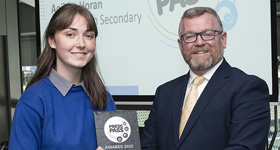
Sports Category - 2nd Place
Aoibhe Horan
- Presentation Secondary School, Milltown
Life is But a Dream for Monika Dukarska
Monika began rowing with Killorglin Rowing Club at the age of 16 when she moved to Ireland from Poland with her family. “I got introduced to rowing in my first week at the Intermediate School Killorglin. I was tall and skinny, and as height is an advantage in rowing, I got asked to join Killorglin Rowing Club. I decided to give it a go and I haven’t looked back since.”
In 2019, along with Aileen Crowley, she qualified the women’s pair boat for the Tokyo 2020 Olympics at the World Rowing Championships in Linz, Austria. Then lockdown hit and the Olympics were postponed until 2021. “During lockdown I learned that it is very important to slow down and take care of yourself. As a high-performance athlete I’m very driven and goal orientated and sometimes I ignore the need to rest or detach from the intense performance driven environment.”
When the Olympics finally rolled around, Monika says it was the experience of a lifetime. She raced in the women’s pair event along with Aileen Crowley. They finished 4th in their first heat of the games. They narrowly missed out on a place in the A/B semi-final, however, they managed to reclaim a spot by coming 3rd in the repechage. They finished 5th in the semi-final and raced in the B final, coming 5th placing them 11th in the world. “Japan was spectacular even though we didn’t see much of the tourist specific sites. It was a privilege to line up for Ireland at the Olympic Games, as it’s the biggest sporting event in the world and comes around every four years. I think getting to the Olympics would be my biggest achievement so far. I think competing at such a global and rare event, as it only comes around every four years makes this more valuable than racing at a World Championship or World Cup event.”
Thanks to the success of Irish rowers in Rio 2016 and more recently Tokyo 2020, rowing has gained popularity as a sport in Ireland. According to the Rowing Ireland website, there are almost 4000 registered racing members in more than 70 clubs and universities around the country with the overall rowing community expected to be at two or three times that number. However, getting to the Olympics was no mean feat. With big interest and few spaces, it is an extremely competitive sport. Getting the seat in the boat and keeping it is not easy. “Usually, we train two to three times a day. My usual day at the National Rowing Centre would start at 8:00am and finish around 11:00am. After that, we might have a weight session, which would probably take place from 1:00pm to 2:30pm and then we would be back in the centre again to do another aerobic session around 5:00pm.”
“Rowing training takes up a lot of time as it is an endurance sport, so we are required to do a lot of kilometres to build our endurance base. A typical week would consist of 220 kilometres of rowing.”
In this busy world of international sport, it is still important to find ways to relax and wind down. “I really enjoy going out and meeting my friends for brunch or coffee. I also enjoy walks with Fiadh, my chocolate Labrador, and she is always up for a good run around or a game of fetch.”
Balancing full time education and an international rowing career isn’t a walk in the park. Having previously achieved a masters in innovation and design, Monika is currently studying for her PhD in education. “I think my tip for managing a busy schedule while studying and rowing would be to be very well organised and plan ahead, as the saying goes ‘failing to prepare is preparing to fail’ and by being very well organised will give you an opportunity to do very well in both academia and sports as you will optimize your time.”
As an international rower, Monika has gained wisdom and learned a lot about herself and life during her time rowing for Ireland and I think we can learn something from what she has to say. “The piece of advice I would give to my younger self would be to pause and acknowledge and appreciate the things I have achieved. I think what I have done over the past few years is to chase after the next goal or the next challenge, rather than stop and acknowledge all the things I have achieved to date and perhaps celebrate it a little bit more.”
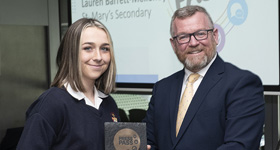
Sports Category - 3rd Place
Lauren Barrett-Melleney
- St. Mary’s Secondary School, Macroom, Co. Cork
Lauren Barrett Melleney
St. Mary’s Secondary School Macroom
GAA. ‘The heart and soul of Ireland.’
The sport that brings everyone together, whether you like it or not. Even if you have no interest in football or hurling, you’re probably going to be dragged into it in one way or another. Whether it be as a player, a player’s partner, a mother, brother or simply the barman at the local pub. You’re probably going to be hearing a lot about it. GAA, although it is the centre of a lot of Irish people’s happiness, is often full of critics, self-absorbed and close-minded people. People who make being part of a team that little harder.
“I could have made county if it wasn’t for my knee.”
Ah, the classic. The junior B unwilling to admit that maybe the reason he didn’t make the senior team was because he hasn’t played decent football since he was u14. Let’s call him Pat. Pat comes to every club game just to roll his eyes and shake his head, pointing out every mistake the full forward (or the man in ‘Pat’s position’) makes – even though he’s scored 1-6. Zip it Pat, just because you scored the winning point in the u12 division final doesn’t make you the saviour of this club.
“It wasn’t our year lads. We had a bad finish this season but let’s make next year a good one. Let’s have pride in the jersey and come back stronger than ever in January.” (Sent via Whatsapp)
The overenthusiastic, painfully dedicated player whose sole purpose in life is GAA. Michael isn’t an evil soul. Michael is the player who sends a text like the one above into the Whatsapp group two hours after we’ve lost the County final. The night which the last thing anyone wants to think about is training next year and putting in all that work again just to lose. Not Michael though, single man, no kids, Michael’s out for a run the following morning. Michael sends the texts that everyone reads and cringes, but can’t not reply to because Michael isn’t a bad man. He’s just excruciatingly enthusiastic.
“I’m finished with it. I won’t be back next year.”
A very common statement, or lie, told usually after being knocked out of championship. The older man, having trained a few teams, sat as chairperson and often has refereed for a few years. Dan is the man everyone knows. Dan is a passionate member of the GAA who has been thrown outside the wire more than once in his lifetime. He usually states the above after having an argument with a fellow middle aged man who is also heavily involved in the club. Dan doesn’t work well with others. It’s probably best if Dan is left to his own devices for a few weeks to cool down. Whatever you say, Dan, we’ll see you next year.
“I told you this team would never win anything.”
The voice every player loves to hear after a big loss (note the sarcasm). Jim hasn’t been seen at a club game since 1990, since he was on the team but always makes sure to be in the village afterwards to tell everyone how he knew this would be the outcome, or how this team couldn’t win an u14 game. Jim was part of the club team with a winning streak in the 1980’s and believes no one – no one – will outdo them. Nor does he want anyone to. Jim, despite his lack of dedication to the club since his own playing days, believes the club owes him everything. If you haven’t gathered already, Jim is a little bitter.
“Ah swap Kevin and Denis. Run with the ball, Connor!”
Barry is always heard on the sideline, spewing ludicrous instructions and unhelpful advice. For instance, Connor is the goalie. Connor, should most definitely not run with the ball. Barry will often tell everyone where the players’ real position is. ‘Why don’t you get involved training them, Barry?’ ‘Oh no, no, I wouldn’t have the time.’ Barry is the dreaded hurler on the ditch.
“If they’d have only passed it to John, we would have won.”
The defensive mammy who never lost her competitive streak. For the purpose of this piece, let’s call her Mary. Mary was a competitive kid, every race, every test, every single thing Mary did, she had to be the best. Unfortunately, when Mary got older and had children, her competitive streak was put on John. John is her youngest son, the older boy and girl both moved away. That left John to believe everything his mother said. ‘John, you are the best full forward this club has ever seen.’ John played full forward only the one time, when they were short ten players. In all honesty, everyone knows John couldn’t tell the goalposts from the ESB poles.
There will always be another Pat, another Michael, Mary, Dan, Jim or Barry. The funny thing is: there wouldn’t be a GAA without them.

Photojournalism - 1st Place
Tia Kenneally
- Blackwater Community School, Lismore, Co. Waterford

Photojournalism - 2nd Place
Jake Sparks
- Presentation Secondary School, Milltown, Co. Kerry




